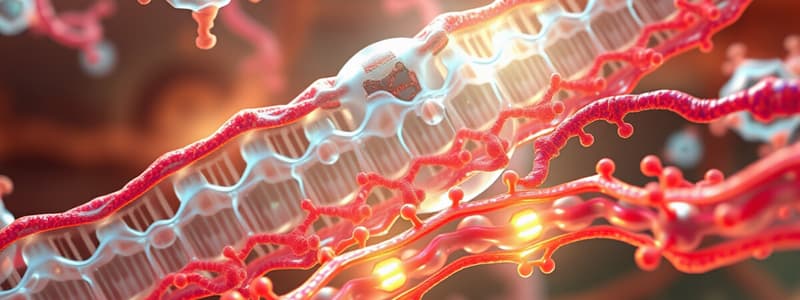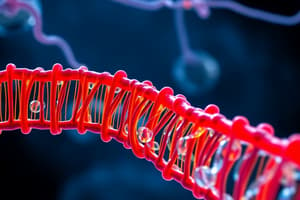Podcast
Questions and Answers
Anchoring proteins attach the cell membrane to inside or outside ______.
Anchoring proteins attach the cell membrane to inside or outside ______.
structures
Recognition proteins label cells as normal or abnormal to the ______ system.
Recognition proteins label cells as normal or abnormal to the ______ system.
immune
Enzymes ______ reactions inside or outside the membrane.
Enzymes ______ reactions inside or outside the membrane.
catalyze
Receptor proteins bind to extracellular ______ such as ions and hormones.
Receptor proteins bind to extracellular ______ such as ions and hormones.
Cytoplasm includes all materials inside the cell membrane but outside the ______.
Cytoplasm includes all materials inside the cell membrane but outside the ______.
Microvilli are finger-shaped projections that increase surface area for ______.
Microvilli are finger-shaped projections that increase surface area for ______.
Ribosomes carry out orders from the nucleus for ______ synthesis.
Ribosomes carry out orders from the nucleus for ______ synthesis.
Cilia are long extensions of the cell membrane that move ______ across the cell surface.
Cilia are long extensions of the cell membrane that move ______ across the cell surface.
There are two types of ribosomes in cells: free ribosomes and ______ ribosomes.
There are two types of ribosomes in cells: free ribosomes and ______ ribosomes.
Smooth endoplasmic reticulum (SER) has no ______.
Smooth endoplasmic reticulum (SER) has no ______.
The Golgi apparatus modifies and packages ______ for exocytosis.
The Golgi apparatus modifies and packages ______ for exocytosis.
Lysosomes are powerful enzyme-containing vesicles that are involved in ______ the cell's internal environment.
Lysosomes are powerful enzyme-containing vesicles that are involved in ______ the cell's internal environment.
Mitochondria produce energy in the form of ______.
Mitochondria produce energy in the form of ______.
The nucleus is the cell's control center and contains all of our ______.
The nucleus is the cell's control center and contains all of our ______.
Chromatin is loosely coiled DNA that is present when cells are not ______.
Chromatin is loosely coiled DNA that is present when cells are not ______.
Peroxisomes break down fatty acids and other organic compounds, producing the dangerous free radical ______.
Peroxisomes break down fatty acids and other organic compounds, producing the dangerous free radical ______.
Each mRNA codon translates to one ______ in a polypeptide chain.
Each mRNA codon translates to one ______ in a polypeptide chain.
Transfer RNA (tRNA) delivers free ______ to the mRNA.
Transfer RNA (tRNA) delivers free ______ to the mRNA.
The anticodon binds to a specific mRNA ______.
The anticodon binds to a specific mRNA ______.
Enzymes join the amino acids together in a ______ chain.
Enzymes join the amino acids together in a ______ chain.
A mutation is a change in the nucleotide sequence of a ______.
A mutation is a change in the nucleotide sequence of a ______.
Selectively permeable membranes allow some materials to move freely and restrict ______ others.
Selectively permeable membranes allow some materials to move freely and restrict ______ others.
Transport through a cell membrane can be active or ______.
Transport through a cell membrane can be active or ______.
The electrical charge inside the cell membrane is slightly ______.
The electrical charge inside the cell membrane is slightly ______.
Cells in a malignant tumor spread into surrounding tissues and start new tumors through a process called ______.
Cells in a malignant tumor spread into surrounding tissues and start new tumors through a process called ______.
An illness that disrupts normal cellular controls and produces malignant cells is called ______.
An illness that disrupts normal cellular controls and produces malignant cells is called ______.
Mutated genes that disrupt normal cellular controls are known as ______.
Mutated genes that disrupt normal cellular controls are known as ______.
In order for tissues to form, cells must ______ or specialize into different types.
In order for tissues to form, cells must ______ or specialize into different types.
All your body cells (except sex cells) contain the same ______ chromosomes.
All your body cells (except sex cells) contain the same ______ chromosomes.
A human being grows from 1 cell to 75 trillion cells by cell ______.
A human being grows from 1 cell to 75 trillion cells by cell ______.
Most of a cell’s life is spent in a non-dividing state called ______.
Most of a cell’s life is spent in a non-dividing state called ______.
In DNA replication, DNA strands unwind and DNA ______ begins attaching complementary nucleotides.
In DNA replication, DNA strands unwind and DNA ______ begins attaching complementary nucleotides.
Mitosis occurs in 4 stages: ______, metaphase, anaphase, telophase.
Mitosis occurs in 4 stages: ______, metaphase, anaphase, telophase.
During metaphase, chromosomes align in a plane between the ______.
During metaphase, chromosomes align in a plane between the ______.
In anaphase, chromosomes pull apart into 2 daughter ______.
In anaphase, chromosomes pull apart into 2 daughter ______.
Cytokinesis divides the cytoplasm into 2 ______ cells.
Cytokinesis divides the cytoplasm into 2 ______ cells.
A benign tumor is contained and not ______ threatening.
A benign tumor is contained and not ______ threatening.
Flashcards are hidden until you start studying
Study Notes
Membrane Proteins
- Anchoring Proteins: Secure the cell membrane to internal or external structures.
- Recognition Proteins: Distinguish normal from abnormal cells for immune system response.
- Enzymes: Facilitate biochemical reactions inside or outside the membrane.
- Receptor Proteins: Bind to extracellular molecules like ions and hormones.
- Carrier Proteins: Transport solutes across the cell membrane using energy.
- Channels: Pores that control the movement of water and specific solutes.
Membrane Carbohydrates
- Extend beyond the cell membrane for various functions including:
- Lubrication and Protection: Create a protective layer around cells.
- Anchoring and Locomotion: Assist in stabilizing cells and enabling movement.
- Specificity in Binding: Engage with receptors for targeted interactions.
- Recognition: Play a role in the immune response to identify cells.
The Cytoplasm
- Composed of all materials inside the cell membrane but outside the nucleus, containing:
- Cytosol: The thick liquid with nutrients, ions, and proteins.
- Organelles: Structures that perform specific functions within the cell.
Non-Membranous Organelles
- Cytoskeleton: Provides shape and strength to the cell.
- Microvilli: Increases surface area for absorption; connected to the cytoskeleton.
- Centrioles: Form spindle apparatus necessary for cell division.
- Cilia: Long extensions that help move fluids across the cell surface.
- Ribosomes: Synthesize proteins; can be free in cytoplasm or fixed to endoplasmic reticulum.
Membranous Organelles
- Endoplasmic Reticulum (ER):
- Smooth ER: Synthesizes lipids, lacks ribosomes.
- Rough ER: Involved in protein and glycoprotein synthesis, studded with ribosomes.
- Golgi Apparatus: Modifies and packages proteins for exocytosis using stacked cisternae.
- Lysosomes: Contain enzymes to break down waste and toxins within cells.
- Peroxisomes: Enzyme-containing vesicles that decompose fatty acids and produce hydrogen peroxide.
- Mitochondria: Produce ATP through aerobic metabolism, essential for cellular energy needs.
The Nucleus
- Largest organelle, control center of the cell, surrounded by a nuclear envelope with pores for communication.
- Contains DNA in two forms:
- Chromatin: Loosely coiled DNA active during non-dividing state.
- Chromosomes: Tightly coiled DNA formed during cell division.
Genetic Information Storage
- mRNA codons translate to specific amino acids in protein synthesis.
- tRNA delivers amino acids to mRNA based on anticodon matching.
- Polyribosomes can simultaneously read a single mRNA for multiple protein copies.
Transport Mechanisms
- Cell membranes are selectively permeable, allowing certain substances to pass.
- Transport Methods:
- Passive Transport: No energy required, includes diffusion.
- Carrier-Mediated Transport: Can be passive or active.
- Vesicular Transport: Active transport method.
Transmembrane Potential
- Electrical charge difference across the membrane: negative inside and positive outside, crucial for muscle and nerve function.
Cell Life Cycle
- Human development involves cell division from one cell to about 75 trillion.
- Interphase: Major portion spent in a non-dividing state, where DNA replication occurs.
- Mitosis Stages:
- Prophase: Chromatids coil into visible chromosomes.
- Metaphase: Chromosomes align on the metaphase plate.
- Anaphase: Daughter chromosomes pull apart.
- Telophase: Nuclear membranes reform, and chromosomes uncoil.
Cytokinesis
- Division of the cytoplasm into two new daughter cells following mitosis.
Cancer and Cell Division
- A tumor is an abnormal mass from uncontrolled cell division.
- Benign Tumor: Non-threatening, localized growth.
- Malignant Tumor: Invades surrounding tissues and can metastasize.
- Mutations: Changes in DNA sequence can lead to cancer through disruption of normal controls.
Cell Diversity and Differentiation
- All cells possess the same DNA but differentiate based on gene activation or inactivation.
- Specialized cells contribute to tissue formation (e.g., liver cells, neurons).
Studying That Suits You
Use AI to generate personalized quizzes and flashcards to suit your learning preferences.




